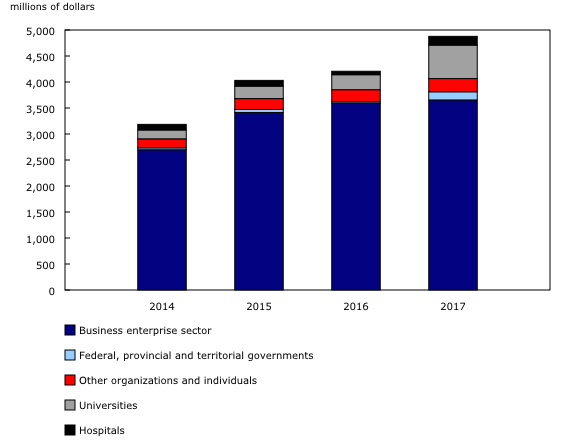Industrial research and development characteristics, 2017 (actual), 2018 (preliminary) and 2019 (intentions)
Archived Content
Information identified as archived is provided for reference, research or recordkeeping purposes. It is not subject to the Government of Canada Web Standards and has not been altered or updated since it was archived. Please "contact us" to request a format other than those available.
Released: 2019-08-26
In-house industrial research and development (R&D) spending edged down 0.2% from 2016 to $18.7 billion in 2017. Preliminary estimates for in-house R&D spending indicate a further drop to $17.7 billion in 2018 and a signal of intent to spend $18.3 billion on R&D activities in 2019.
Businesses in Canada continue to expand outsourced R&D activities; increase in funding to university R&D programs leads outsourcing expenditures in 2017
Outsourced R&D expenditures by companies in Canada rose for the third consecutive year, up 15.9% to $4.9 billion in 2017. R&D activities outsourced to Canadian universities increased for the second year, more than doubling from 2016 to $616 million. This trend reflects increased collaboration between the business sector and the higher-education sector, which consists of universities and hospitals.
Companies in Canada intended to continue their current level of outsourcing of R&D activities, with preliminary estimates of spending for 2018 at $3.9 billion, and intentions of spending at $4.1 billion for 2019.
Services-producing industries lead in-house R&D spending
Services-producing industries, which accounted for the majority of all in-house industrial R&D expenditures in 2017, increased R&D spending by 2.4% from 2016. The second largest sector, manufacturing, decreased in-house R&D expenditures by 2.6% over the same period. The shift of R&D activities from manufacturing to services-producing industries reflects increases in both job creation and economic growth in Canada's services-producing industry for this time period.
Nearly two-thirds (64.0%) of Canadian R&D personnel were employed by services-producing industries in 2017, while about one-third (32.5%) worked in manufacturing.
Decrease in spending on in-house R&D capital
In 2017, current in-house R&D expenditures were unchanged at $17.6 billion, while in-house R&D expenditures on capital declined 5.0% to $1.1 billion, accounting for the slight decrease of in-house R&D spending.
Wages and salaries, which accounted for over two-thirds of current in-house R&D expenditures, increased 1.6% to $12.0 billion in 2017.
Lower in-house expenditures on R&D materials (down $218 million) and the decrease in all other current costs (down $242 million) were partly offset by higher spending on services to support R&D (up $293 million).
Foreign-controlled firms account for more than one-third of in-house R&D spending
Foreign-controlled firms accounted for more than one-third of in-house industrial R&D spending for the fourth consecutive year, with expenditures increasing 2.8% to $7.0 billion in 2017.
Overall decrease in R&D personnel in 2017
The total number of R&D personnel decreased from 146,964 full-time equivalents (FTEs) in 2016 to 144,570 FTEs in 2017.
Scientists, researchers, and research managers accounted for nearly three-quarters of the overall decline of R&D personnel, while the number of R&D technicians and support staff edged up 0.2%. Total wages and salaries for these groups of employees were essentially unchanged from 2016 to 2017.
The number of on-site contractors working on R&D activities in 2017 decreased 11.3% to 6,048 FTEs, continuing the downward trend that began in 2015. On-site contractors are generally hired to support project-based or short-term R&D activities with defined end dates.
Sustainable Development Goals
On January 1, 2016, the world officially began implementation of the 2030 Agenda for Sustainable Development—the United Nations' transformative plan of action that addresses urgent global challenges over the next 15 years. The plan is based on 17 specific sustainable development goals.
Data on the characteristics of research and development in Canadian industry are an example of how Statistics Canada supports the reporting on the Global Goals for Sustainable Development. This release will be used in helping to measure the following goal:

Note to readers
These data are subject to revision.
Research and experimental development comprise creative and systematic work carried out to increase the stock of knowledge—including knowledge of humankind, culture and society—and to devise new applications for the available knowledge.
In-house research and development (R&D) expenditures refers to expenditures within Canada for R&D performed within the company by employees (permanent, temporary or casual) and self-employed individuals who are working on-site on the company's R&D projects.
On-site research and development (R&D) contractors are on-site personnel hired to perform specialized project-based R&D work under supervision and direction of the contracting organizations, and are considered separate from industrial R&D personnel.
Products
The new interactive dashboard "Characteristics of research and development in Canadian industry" (71-607-X) is now available.
Contact information
For more information, or to enquire about the concepts, methods or data quality of this release, contact us (toll-free 1-800-263-1136; 514-283-8300; STATCAN.infostats-infostats.STATCAN@canada.ca) or Media Relations (613-951-4636; STATCAN.mediahotline-ligneinfomedias.STATCAN@canada.ca).
- Date modified:



